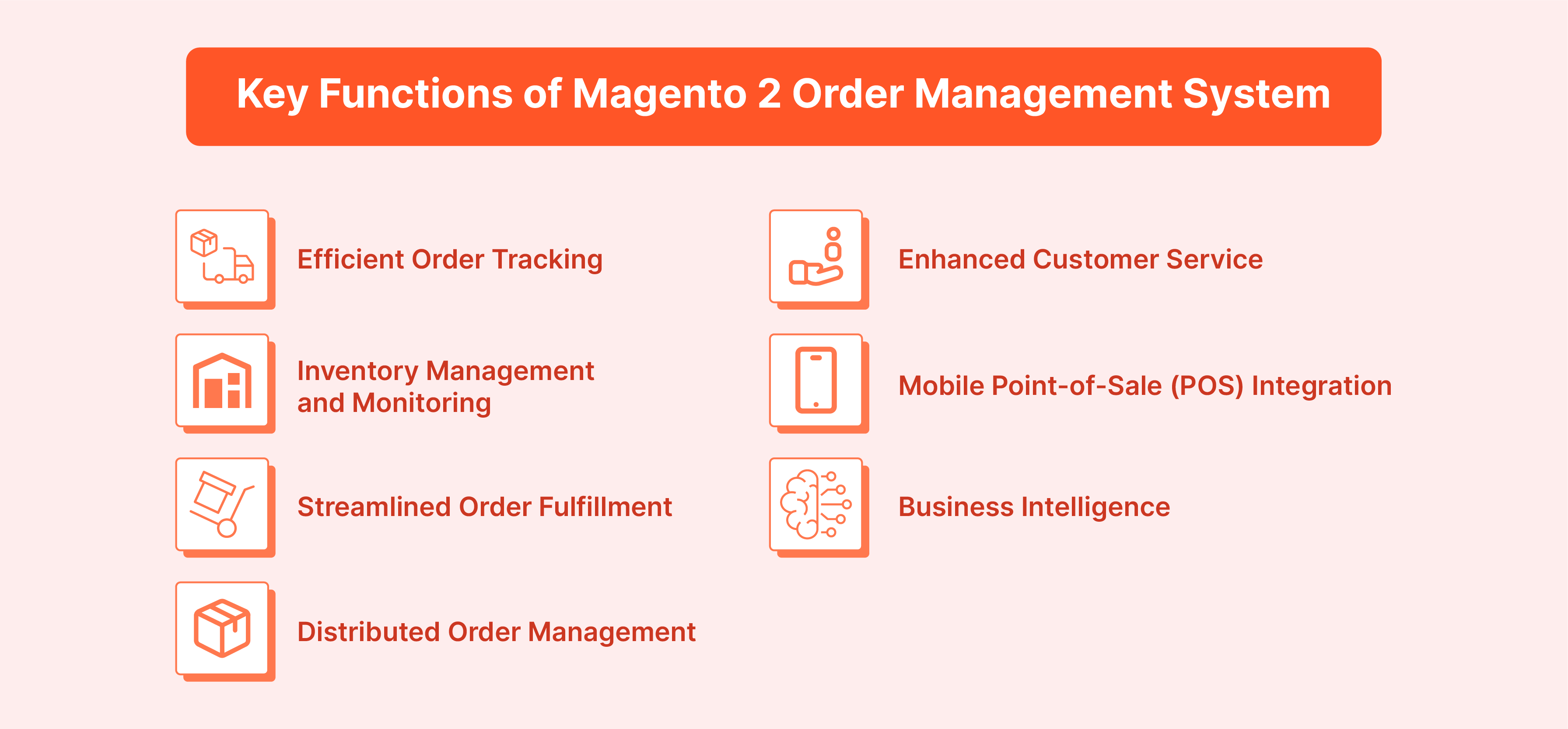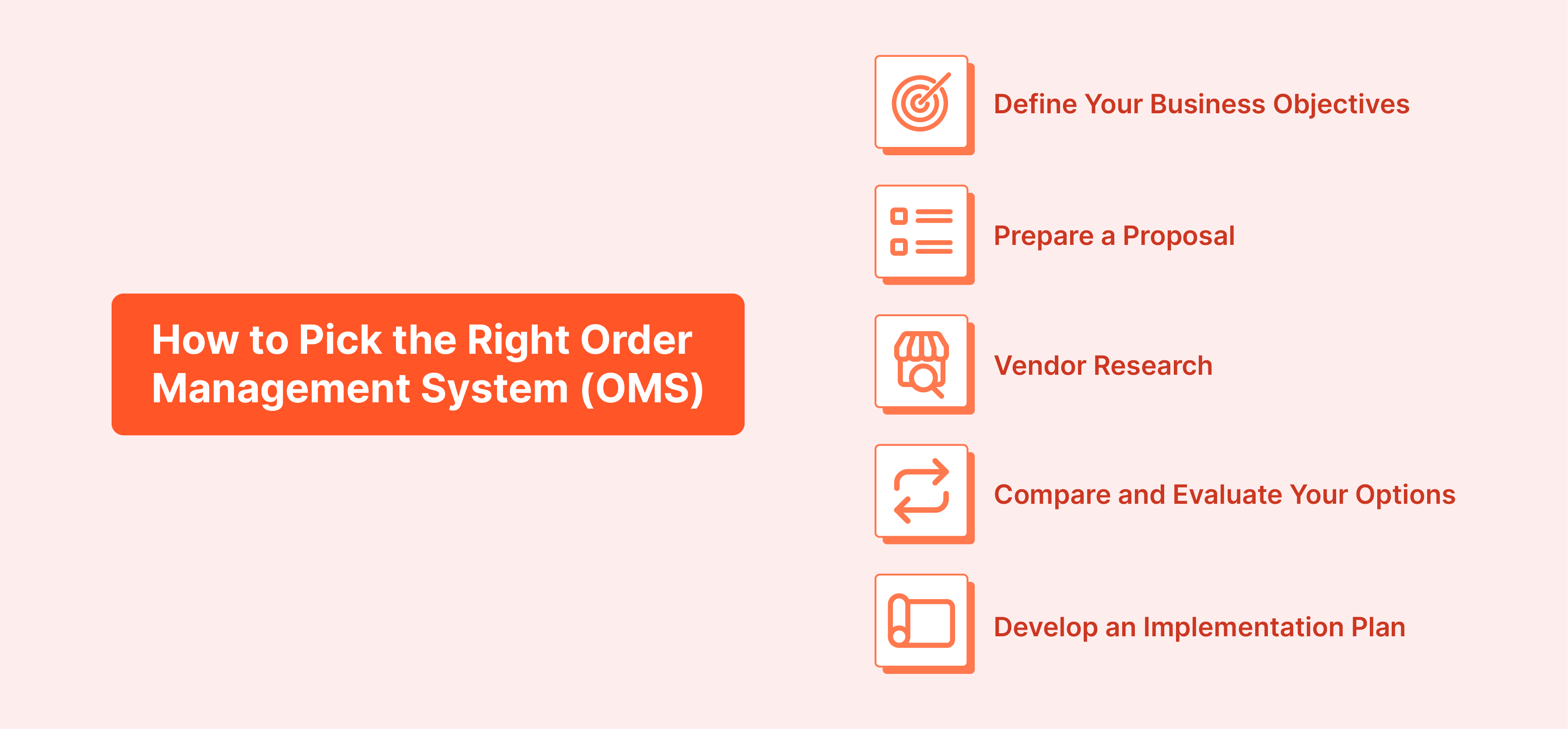
Choose the Right Magento OMS: Order Management System
Magento OMS, or Order Management System, is a software solution that assists businesses in efficiently managing their order processes. This platform enables businesses to manage orders from various sales channels through a centralized system. With Magento OMS, companies can monitor real-time inventory levels and ensure precise order fulfillment. It offers features for order routing, inventory allocation, and handling returns. This blog post will explore Magento OMS and the factors to consider when selecting the ideal OMS for your business.
Key Takeaways
-
Discover how Magento OMS integrates various sales channels for efficient order processing and real-time inventory management.
-
Explore the key functions of Magento 2 Order Management System, enhancing order tracking and inventory management.
-
Learn about different types of Magento Order Management Systems, from manual to integrated e-commerce platforms.
-
Explore the advantages of implementing Magento OMS, including enhanced data entry, reduced errors, and improved customer service.
-
Learn to choose the right Magento OMS by considering integrations, scalability, and real-time information.
-
Discover the steps to select the right OMS, from defining business objectives to vendor research and implementation planning.
-
Find out how to set up and configure Magento OMS efficiently, ensuring seamless integration with your online store.
What is Magento OMS?

Magento OMS, or Magento Order Management System, integrates various sales channels in Magento 2. It includes web, mobile, offline stores, dropshipping, and affiliate networks. This consolidation enables merchants to monitor and fulfill customer orders efficiently. Orders are from multiple sales channels, warehouses, and suppliers.
It offers real-time visibility into critical aspects of the business, such as inventory levels, order statuses, and shipping updates. This real-time data empowers businesses to provide exceptional customer experiences by ensuring accurate and timely order fulfillment.
It also provides advanced analytics and reporting capabilities. These tools enable merchants to make informed, data-driven decisions that enhance operational efficiency.
Key Functions of Magento 2 Order Management System

1. Efficient Order Tracking
Magento 2 Order Management ensures order tracking and identifies the source of the order, whether it's via phone, mail, or online. The system tracks shipment history accurately and allows access to customer messages, including emails and live chats. This capability enables prompt responses from sales and customer service teams.
2. Inventory Management and Monitoring
Magento OMS provides inventory monitoring features that help monitor product-specific inventory levels and set stock availability flags. It aids in informed decisions about stock adjustments, ensuring shelves are appropriately stocked. It also allows businesses to operate as efficient distribution centers for multi-store inventory and online sales.
3. Streamlined Order Fulfillment
The management panel for orders streamlines order fulfillment and offers an overview of all orders, their sources, and the processing merchant. You can also view expected shipment dates, locations, and track the number of processed orders, enhancing operational efficiency.
4. Distributed Order Management
Magento OMS efficiently handles orders from multiple locations. It is particularly advantageous for businesses with large warehouses or international offices. It enables simultaneous order processing rather than a sequential, one-by-one approach throughout the day.
5. Enhanced Customer Service
An essential role of an order management system is providing customer service. Magento 2 OMS functions as a "phone tree," allowing customers to reach various departments. It facilitates live chat, timely email responses, and SMS notifications to address customer issues effectively.
6. Mobile Point-of-Sale (POS) Integration
Magento seamlessly integrates with POS systems for diverse payment acceptance. It securely processes customer’s credit card information. It transmits it to the back-end system for processing. This integration simplifies order modifications and enhances the use of essential customer service tools.
7. Business Intelligence
Magento OMS leverages order management analytics, providing valuable insights into orders, shipments, returns, and payments. This data-driven approach aids in optimizing business operations.
Types Of Order Management Systems
-
Manual Order Management: Manual order management relies on human intervention without integrated software support. It typically involves using tools like Excel spreadsheets, paper records, or software not designed for order management. While suitable for small-scale operations, it becomes impractical for businesses handling large orders. Manual processes can lead to inefficiencies, errors in tracking, and inventory mismanagement.
-
E-commerce Platform Integration: E-commerce platforms like Magento offer secure and user-friendly solutions. They seamlessly integrate with existing websites, enabling comprehensive orders, inventory levels, sales, and customer data tracking. These platforms often include features like point-of-sale (POS) integration. It helps integrate various payment methods and detailed sales record-keeping, exportable in formats like AJAX or CSV files.
-
Standalone Order Management Software: Standalone OMS operates independently and does not integrate with other software, such as e-commerce platforms. It functions as an online store within your website, facilitating efficient order and inventory management. Some standalone OMS options also support POS transactions and Magento payments.
-
Enterprise Retail Platform (ERP) Software: ERP software is an OMS and a POS system. While some ERP systems operate independently, others offer integration with existing websites. They can integrate with diverse software, including accounting tools and warehouse management systems. Certain ERP systems function as standalone tools. Others require additional plugins for specific features like third-party shipping or supply chain management.
-
Digital Operations Platform for Retail: A digital Magento OMS integrates with existing websites and other software like accounting and warehouse management tools. However, it needs integration with an existing Magento website. Benefits of this solution include unified platforms, enabling efficient order and inventory management within a single system. Integration with ERP or POS systems can further enhance the comprehensive retail system for your business needs.
Advantages of Implementing Magento OMS
1. Efficient Data Entry
Magento OMS streamlines data entry, making it faster and more user-friendly. Store owners can input customer details, orders, and inventory information with minimal effort. It reduces the time spent on mundane tasks.
2. Enhanced Visibility
Magento OMS offers real-time order reporting and analytics tools, informing you about sales trends and customer behaviors. It enables you to identify top-selling products and potential candidates for promotions. Enhanced visibility extends to supply chain management, aiding decision-making and growth planning. Access to accurate data facilitates customer satisfaction and optimizes retail operations.
3. Reduced Human Error:
Increased visibility within Magento OMS translates to fewer Magento errors. The system automates tasks prone to human mistakes, such as form filling, stock updates, and order processing. It eliminates the risk of incorrect shipments or inventory mix-ups. Improved accuracy contributes to the smooth and professional operation of your business.
4. Multi-Channel Sales
Magento order management software simplifies store and product management integration across various sales channels. This single platform serves both online and offline sales, providing a unified management solution.
5. Sales Support
Offering customer support and communication helps improve customer loyalty and revenue growth. Magento OMS includes features like live chat and email communication, demonstrating your commitment to customer care.
6. Customer Database
It helps you easily create custom fields for customer details, linking them to orders and inventory in your Magento shop. This feature offers quick access to valuable customer information.
7. Third-Party Integration
Magento OMS allows integration with third-party tools, such as accounting software, shipping solutions, and point-of-sale devices. While not included by default, businesses can purchase and integrate these additional tools as needed.
8. Global Inventory
Magento offers multi-language support and enables inventory tracking across multiple global locations. The multi-site feature allows you to efficiently manage multiple online stores through a single order management system. It helps you save time and simplify the complexities of running a global eCommerce site.
How to Pick the Right Magento OMS for Your Business

-
Integrations: Assess the OMS's ability to integrate seamlessly with your existing business software and transfer essential data.
-
Inventory Management: Ensure the OMS provides efficient tools for inventory management, saving time and reducing errors associated with manual inventory tracking.
-
Supply Chain Implications: Evaluate how the OMS will impact your supply chain, especially when dealing with a global web store. Accuracy and efficiency in delivery are important in ecommerce platforms.
-
Reporting & Analytics: Verify that the chosen OMS offers a variety of reporting and analytics tools. It helps track key business metrics and gain valuable insights.
-
Scalability: Consider the software's capability to accommodate business growth, particularly if you plan to scale your online store rapidly.
-
Real-Time Information: Seek an OMS that provides real-time product information for accurate representation on your website. It enhances faster order fulfillment, reducing processing time and costs.
-
Multiple Devices: Ensure the OMS supports multiple devices. It should also facilitate multitasking for business owners managing various channels, including mobile apps.
-
Customer Service Capabilities: Look for features that enhance customer service, such as direct communication channels. Look for features like automated order processing based on past purchasing decisions.
-
Support for Growth & Expansion: Choose a vendor offering custom Magento add-ons and upgrades to support future growth without concerns about contract updates.
-
Cloud-Based: Consider the advantages of a cloud-based OMS, which offers flexibility, ease of installation, and quick implementation. It allows you to establish your online store swiftly and efficiently.
Steps to Select the Right Order Management System (OMS)
1. Define Your Business Objectives
Begin your OMS selection process by clearly defining your business objectives and requirements. Consider factors like the volume of inventory you manage, the size of your business, and your budget constraints. Understanding your specific needs will guide you in prioritizing the features necessary for efficient order management.
2. Prepare a Proposal
Create a detailed proposal that outlines the features and functionalities you expect from your chosen OMS. Be explicit about the inventory management system that suits your business model. Provide examples or samples of similar systems that align with your needs.
Use a reliable proposal maker to create a well-thought-out proposal to ensure both you and potential vendors have a clear understanding of your expectations.
A well-thought-out proposal ensures that both you and potential vendors have a clear understanding of your expectations.
3. Vendor Research
Take the time to research different Magento OMS vendors and their product offerings. You can gather information by visiting their websites or engaging with customer service representatives. Before contacting any vendor, conduct due diligence on their reputation and credibility in the market. Ensuring you work with a reputable vendor is essential for a successful OMS implementation.
4. Compare and Evaluate Your Options
Once you've selected a vendor, comparing and evaluating the available options is essential. Examine the value proposition the software offers with its pricing structure. Consider more than just the number of features but their practicality and relevance to your business needs. Compare different vendors to determine what best suits your specific requirements and budget.
5. Develop an Implementation Plan
Collaboration with your chosen vendor ensures a successful OMS implementation. Develop an implementation plan outlining the steps and timelines for deploying your online store. Ensure that this plan includes important dates, detailed descriptions of tasks, and a clear timeline for testing and development. This proactive approach helps avoid delays and unnecessary Magento costs by addressing potential issues in advance.
Setting Up and Configuring Magento Order Management System (OMS)
-
Installation of Magento OMS: Setting up and configuring Magento OMS requires just a few steps. Initially, ensure that you have the latest version of Magento installed on your server. Subsequently, visit the Magento Marketplace and obtain the Magento OMS extension.
-
Integration with Magento Admin Panel: After successfully downloading the extension, access your Magento admin panel and navigate to the Extensions tab. Locate the Magento OMS extension and proceed to click on "Install."
-
Configuration of OMS Settings: Once the installation is complete, configure the OMS settings to tailor it to your specific requirements. These settings include defining inventory sources, configuring shipping methods, and establishing rules for order fulfillment.
-
Customization and Integration: Besides the fundamental settings, you can customize notifications and manage returns efficiently. You can also seamlessly integrate with third-party systems to enhance overall efficiency in your business operations.
FAQs
1. What plugins can be integrated with Magento OMS to enhance functionality?
Magento OMS supports a variety of Magento plugins that cater to different business needs. It helps improve automation, optimize customer experience, and streamline inventory management. You can also explore options compatible with Magento OMS for tailored enhancements.
2. How does Magento OMS contribute to an improved customer shopping experience?
Magento OMS enhances the shopping experience by providing real-time information on inventory, order statuses, and shipping updates. It ensures accurate and timely order fulfillment, meeting customer expectations for a seamless and reliable shopping process.
3. Can retailers integrate third-party APIs with Magento OMS?
Yes, retailers can integrate third-party APIs seamlessly with Magento OMS. This flexibility allows businesses to incorporate additional tools. These tools include accounting, shipping solutions, and point-of-sale devices.
4. What steps can businesses take to meet customer expectations effectively with Magento OMS?
Businesses can leverage Magento OMS features like live chat, timely email responses, and SMS notifications to meet customer expectations. These communication channels, order tracking, and efficient order processing create a positive customer experience.
5. How does Magento OMS address the performance concerns of ecommerce businesses?
Magento OMS addresses performance concerns by offering real-time reporting and analytics tools. This data-driven approach enables businesses to track key metrics, identify sales trends, and optimize operations. Its support for multiple devices also ensures efficient multitasking for business owners managing various channels.
6. Is Magento hosting important for successfully implementing Magento OMS?
Yes, a reliable Magento hosting service ensures smooth performance, faster data processing, and overall system stability. It contributes to the effective functioning of the order management system.
7. How can marketing efforts be streamlined with Magento OMS for an ecommerce business?
Magento OMS streamlines marketing efforts by providing valuable insights through analytics tools. Businesses can identify top-selling products, plan promotions, and make informed decisions based on real-time data.
8. How can Magento OMS examples aid in understanding its functionality?
Magento OMS examples provide practical insights into how businesses utilize the platform for order processing and inventory management. By studying real-life scenarios, users can better grasp the capabilities and benefits of Magento OMS for their own operations.
Summary
Magento OMS ensures efficient order processing, inventory management, and customer satisfaction. With features like real-time visibility into inventory levels and order statuses, businesses can optimize operations and offer a seamless shopping experience.
We covered key functions of Magento OMS, the advantages of its implementation, and types of order management systems. It also highlighted the factors to consider when selecting the right Magento OMS for your business needs. Explore reliable Magento server hosting options to complement the efficiency of Magento OMS.


